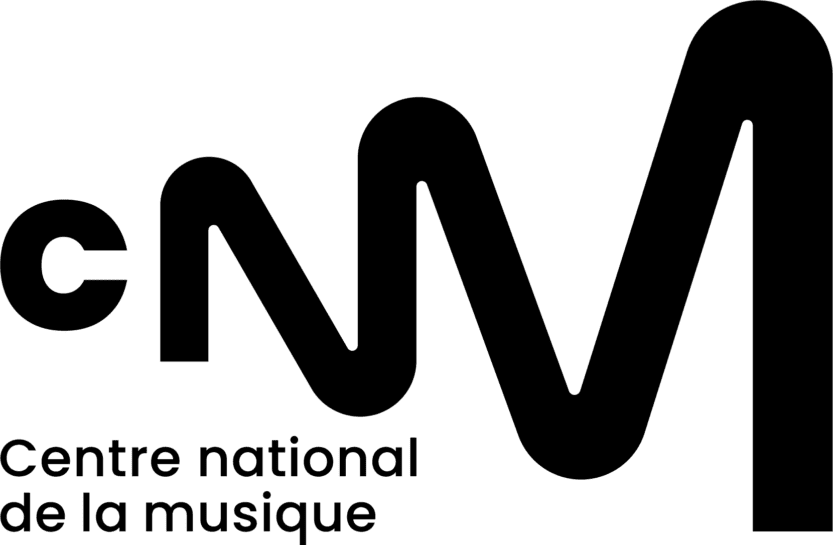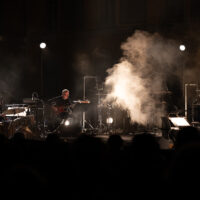Caravaggio and les Percussions de Strasbourg
Caravaggio
Bruno Chevillon, electric bass, electronics
Benjamin de la Fuente, violin, electric guitar
Éric Échampard, drums, electronic pad
Samuel Sighicelli, electric organ, analogue synthesiser, sampler
Les Percussions de Strasbourg
Théo His-Mahier, multi-percussion
Lou Renaud-Bailly, multi-percussion
Emil Kuyumcuyan, multi-percussion
Christophe Schaeffer, lighting design
Vanessa Court, sound
Laurent Fournaise, technical management
Delegated production: Sphota
Festival Musica and GRAME, Centre national de création musicale are co-commissioners of the work composed by Samuel Sighicelli.
Coproduction: Les Percussions de Strasbourg, GRAME, CCAM scène nationale de Vandoeurve-les-Nancy, Festival Musica.
The Festival Musica is co-sponsor of Samuel Sighicelli’s work.
Benjamin de la Fuente’s work was the subject of an original musical work writing grant from the DRAC Auvergne Rhône-Alpes. With the support of SACEM, SACD, DGCA, SPEDIDAM, MMC, DRAC Île-de-France, CNM, and the Francis and Mica Salabert Foundation.
Duration: 1h15
Musical proposition
RuptuR uses a large-scale musical form to create a machine with a rock accent, made up of motifs and patterns that are constantly repeated and renewed, exploring their own colours, spaces and temporalities. The aim is to achieve both the hypnotic effect of repetition and an uplifting movement and emotional tension that builds to a breaking point.
This machine, launched at full speed, develops over more than an hour until it comes to an abrupt stop, as if broken by its own exhaustion, suddenly plunging us into a silent suspension inhabited by a very deep drone, creating an unexpected vertigo.
What happens in the listener’s body and mind at the moment of rupture? Is the stopping of the machine a liberation, a frustration, or both?
Score
De la Fuente and Sighicelli share the maîtrise d’œuvre of the score, following a scenario drawn up together.
The score is made up of 4 pieces – or movements – lasting around 17 minutes, which follow one another without interruption. Each piece has its own particular colour and pace, but what they have in common is the incessant flow of energy that runs through them, sustained by the almost constant presence of a strong tempo.
Each piece, in its own way, reveals a changing, moving texture, a sound material that ‘rolls’ on and on. To achieve this rolling motion, the composers put in place musical proposals and instrumentation that encourage the fusion of the three percussion instruments and the electric instruments of the ensemble. The drums, with their electronic pad, often form the link between the two entities.
The creative process
The physicality of rhythm cannot be composed alone at the table, but must be experienced from within. That’s why Sighicelli and de la Fuente approached this project as a fully shared experience between designers and musicians, of which they are also a part.
The composition process was therefore spread out over a long period so as to experiment over several sessions with the instrumentalists, and thus gradually fix the scores. These experiments were fuelled by improvisation, time spent researching sounds, setting up playing rules and sketching out scores.
The result is a score which, although very carefully chiselled, disappears behind the performance and the musical maturation.
Instrumentarium
The two ensembles merge to form an atypical orchestra of 7 musicians, amplified and augmented by electronics.
Each of the musicians from Les Percussions de Strasbourg and Caravaggio has contributed with an element of invention to his or her instrumental set over the course of the work sessions. The percussion sets include relatively few large classical percussion instruments, and instead numerous small sound objects made of wood, metal and skins, used with various types of mallets and playing modes.
System
RuptuR is a frontal concert. The 7 musicians are arranged in a circle open to the auditorium. In a space with no tiered seating, it is preferable to raise the musicians in the distance on risers so that they can be seen by everyone.
RuptuR is sculpted by lighting designer Christophe Schaeffer, closely linked to the evolution of musical energy over time.
Dates :
16th March 2024 – GRAME, B!ME, Les SUBS, Lyon (Premiere)
30th September 2024 – Festival Musica, Théâtre de Hautepierre, Strasbourg
4th October 2024 – Festival Musica, Arsenal, Metz
16th and 17th October 2024 – CCAM Scène Nationale de Vandœuvre, Vandœuvre-lès-Nancy
27th May 2025 – CRR Concert Hall, Istanbul, Turkey

Downloads
Presentation file RuptuR (in French)
Interview – Creating vertigo with RuptuR, by Guillaume Kosmicki (in French)







